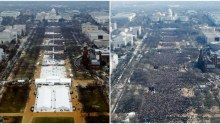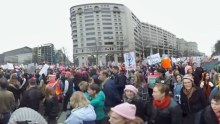High immigration masks Australian economic decline
Updated
Australia has ridden 25 years of economic growth without a recession. An amazing stretch of prosperity and a badge of honour that governments of all persuasions have tried to claim as their own.
Much has been written about the importance of the 1980s economic reforms in setting Australia up for this quarter century of expansion. A mining boom of historical proportions was also a massive help.
But often underappreciated is the role that migration has played. A huge increase in migration has fuelled headline GDP growth, keeping Australia technically out of recession. But, it's also masked a dirty secret, individuals haven't felt the benefit of this record run.
In fact, since the GFC, Australia has seen per capita income go backwards and it's only recently recovered.
The most recent numbers show a slight downturn in the long-term arrivals to departure ratio.
But this is a misleading picture. The truth is, migration to Australia is still proceeding at a record clip.
Much of it fuelled by "temporary" migrants, many of which are not captured in these numbers.
These include some students, 457 workers, working holiday and bridging visa holders - who are generally able to work and many of whom end up staying in the country permanently.
The below table shows that at 30 September 2016 there were nearly 2 million temporary visa holders within Australia. An increase of nearly 5 per cent in just one year.
Even if the visitor visa category is stripped out of the aggregate temporary migration numbers, the total number of temporary migrant entrants sat at 1,608,460, which is a rise of 4.3 per cent in one year.
Overall Australian population growth has averaged 1.7 per cent over the last decade - that's more than double the rate in the US over the same period.
Despite the political heat surrounding "boat people" and asylum seekers, there has been bipartisan support for a huge increase in migration to Australia for a long time.
It's a very simple equation: more people means more economic activity and that gives the government of the day an easy way to keep crowing on about good economic management.
But more people does not mean that the living standards of the existing population also rise. In fact, it can have detrimental economic effects for the people who are already here.
New workers mean greater competition for jobs, which suppresses wages. The most recent data shows that wages growth in Australia has hit a record low of just 1.9 per cent per annum.
More people also mean more demand for scarce goods and services. When there's already a tight supply of a particular good, it can mean huge price rises.
Population growth distorting housing, labour markets
Perhaps the most illustrative example is housing, where prices continue to rise sharply in Australia's two biggest magnets for new migrants, Sydney and Melbourne, putting them outside the reach of many first home buyers.
Sydney house prices have risen more than 70 per cent over the last five years.
"The unemployment rate at the moment is tracking at around 5.75 per cent - that's about 0.75 per cent higher than we would consider full employment, which is 5 per cent," said Gareth Aird, Senior Economist at the Commonwealth Bank.
"That means there's spare capacity in the labour market.
"So I think if you had a lower immigration rate at a time where there is spare capacity in the labour market that's not a bad thing.
"On top of that, we've got incredibly strong house price growth still, and if you've got more people you've got more upward pressure on house prices.
"So, at a time when house prices are still running pretty hot, some cooling in demand through lower immigration isn't a bad thing either."
Bigger pie, but more mouths eating from it
The reason why many people feel that they haven't benefitted from the Australia's long stretch of economic expansion, is quite simply because they haven't.
Their pay packets haven't gotten bigger while the cost of essential goods like shelter have risen.
High migration makes it nearly impossible for Australia to fall into recession.
The economy keeps getting bigger just because there are more people operating in it.
It's great for business, because it keeps wages low and there's more people to buy stuff from them.
It's great for governments because it means economic growth looks better than it otherwise would.
But it isn't necessarily good for ordinary workers.
As new Reserve Bank governor Philip Lowe has noted, the role of good economic policy should be to "raise living standards" - not just make the population, and therefore economy, bigger.
Topics: economic-trends, immigration, housing-industry, housing, australia
First posted











